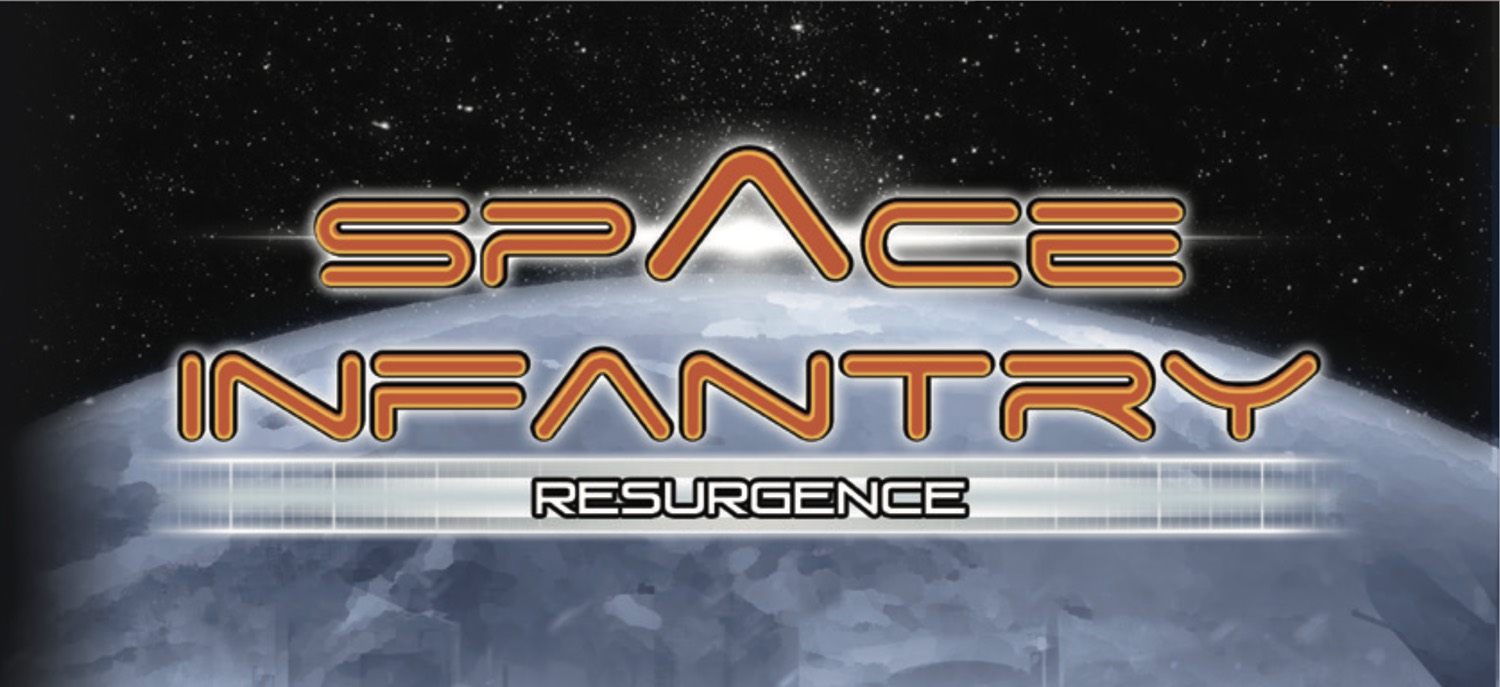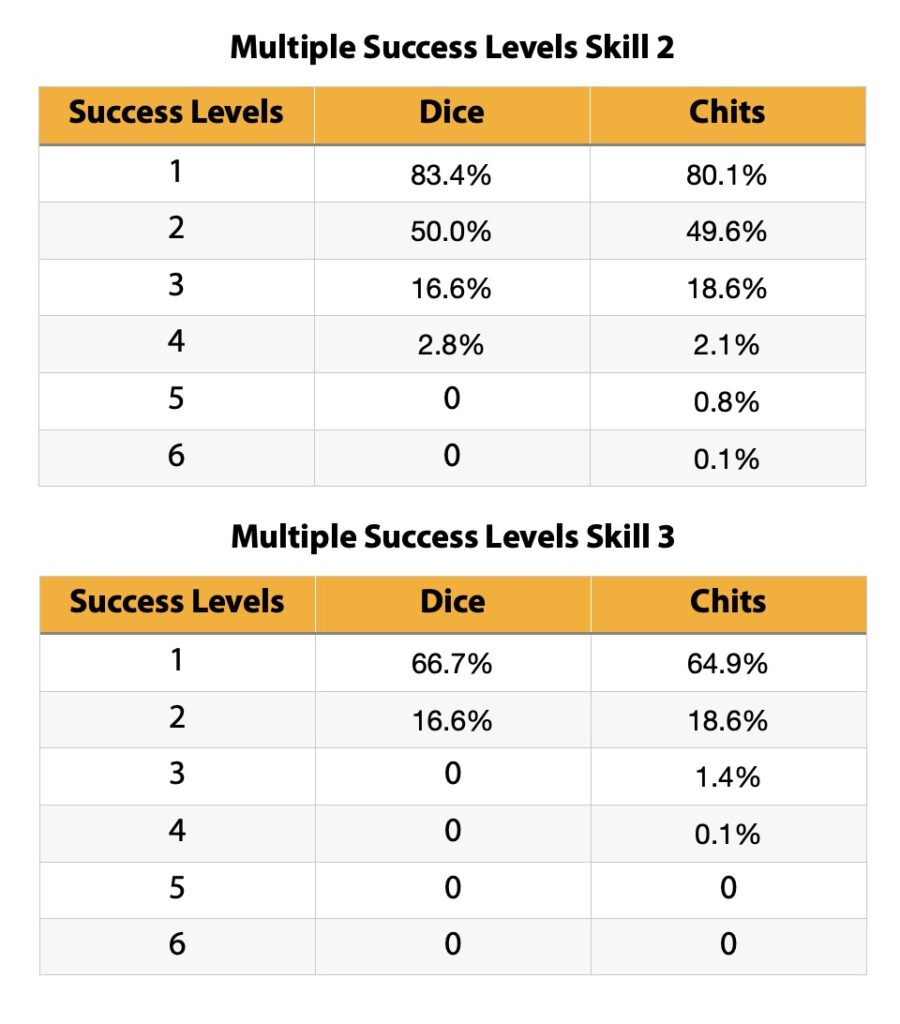 RN generation in Space Infantry Resurgence
RN generation in Space Infantry Resurgence

Space Infantry Resurgence is a game that requires you to generate many random numbers during gameplay. The primary method for random number generation in games is rolling a D6. This only generates numbers from 1 – 6 and the game has instances where the range of possible results required can go from 0-8. For those that want that wider range of results you can get them by using the Extended Dice method detailed in the rules. This second dice-based system generates RNs by using 2D6 and having the second dice be a potential modifier when you roll a 1 or a 6. There is also a third alternative method, and the one from the first version of the game, which is to draw a chit from a cup which will then be the RN. All three methods work well in the game and there are fans of each. Oddly, I prefer the chit draw method even though I tend not to like it in other games.
Each system generates numbers differently which gives a different range of possible results as well as a different distribution of those results. Using a single D6 is a well-known case in which we are all familiar. Each result is equally probably (a flat distribution) and the average value for an RN done using this method is 3.5. This article will look at the two other random number generation systems that the game provides and examine the range of values and distribution you can get using them.
Extended Dice Method
Section 4.2.1 of the Space Infantry rulebook defines the Extended Dice method by which you use 2D6 to generate an RN. One D6 is rolled and if the result is a 1 or a 6 then you roll a second D6. If the result is a 1 and the original dice was a 1 then the final RN is 0. If the result was a 1 or 2 and the original roll was a 6 then you add them together to get an RN of 7 or 8. The range of numbers that you get with this method is from 0 to 8. With the addition of the second die this method results is a distribution of results that is not flat.

1 and 6 appear slightly less frequently because those numbers are used to ‘create’ 0, 7 and 8. 6 appears less often than 1 because it is modified 2 times in 6 by the second dicce (33%) while the 1 result is modified only 1 time in 6 (16.6%). This will result in a distribution that looks like this:

You are almost 6 times as likely to generate a number from 2-5 as you are a 0, 7 or 8. Interestingly enough the average RN value using this method is 3.6 which is only slightly higher than using a single D6.
Chit Draw
Space Infantry also has a series of counters that you can use to generate RNs. There are twenty counters with three of each number from 1 to 6 and then a single 0 counter and one ‘+’ counter. If you draw the ‘+’ you then draw two more counters and sum them to get your final RN.
The first thing to notice is that even though there is a possible zero result it will be drawn much less frequently than the other numbers. In fact it will happen slightly less than a third less frequently. This system will also generate numbers from 0 to 12 since there is no cap on the maximum value for an RN that you generate.
The ‘+’ counter adds some noise to the distribution of results because it has a special case. If you have no chits left, or only one, when you draw the ‘+’ you need to return the chits to the cup and draw again. This upsets the distribution of values since it means that you can draw a chit more than three times in a sequence of draws depending on when the ‘+’ is drawn.

This system will result in an RN with a value of zero approximately twice as often. Also notice that values higher than 6 are much less likely to happen.

Comparison
Despite all of the noise in the data and the extended range, the average result for this system is 3.5 which is the exact same as using a single D6 and also very close to the Extended Dice system. Here is a chart of the two systems compared:

The two RN generators will give you approximately similar results with the chit draw system throwing out an RN of zero more often and occasionally giving out an RN from 7 to 12. Another way to look at it is that both systems have an approximately equal chance of giving you a result higher than 6 with the Chit Draw method giving you a wider range of results within that same range of probabilities.
Success Levels
So all that is interesting but the game depends on you using those RNs to create Success Levels and complete tasks or hit opponents in combat. So while the average RN for each system is approximately 3.5 what are the percentage chances that you will get a success with an RN using either system?
Since we have the percentage change for getting a particular value the overall chance of rolling or drawing a chit to match or exceed that skill level is equal to the sum of all the percentages for that value and higher. So for the Extended Dice system the chance of getting a success with a Skill Level of 2 is: 16.7% + 16.7% + 16.7% + 16.6% + 11.1% + 2.7% + 2.8% which is 83.4%. Here are some tables that have the values calculated already.


Both systems generate numbers that are nearly identical. Which is useful for analysing your chances of success at a task but also because it means that your game experience shouldn’t vary depending on which RN generation system you choose.
Multiple success results
Getting on Success Level is good but the game allows you to generate multiple SLs from the same RN generation. Not only is this very helpful in the game but it also makes for some interesting narrative moments when you pull your squad out of combat with a precise burst of fire or open up a critical Node in one attempt. Calculating the changes of multiple success also uses the same math as calculating a single Success Level.
If your Skill level is 2 then you create an additional Success Level at full multiples of 2 – 4, 6, 8 etc. So to determine the chance of that happening we need to add the percentages for the results that are a multiple of the Skill Level. So the chance of getting two SLs with a Skill Level of 2 is the sum of all of percentages for a result of 4 and above – 16.7% + 16.6% + 11.1% + 2.7% + 2.8% for a total of 49.6%.
The Extended Dice method caps RN values at 8 so that places an upper limit on the number of success that you can create. The Chit Draw method has a higher limit which makes a slight difference in the percentage chance of getting a multiple SL result but it also means that Skill Level 3 has more opportunities for multiple SLs than using the Extended Dice method which can’t generate a value higher than 8 and so can only allow for three RN results (6, 7 and 8) for Skill Level 3 but five (4,5,6,7 and 8) for Skill Level 2.

For Skill Level 2 both RN generation methods offer similar results with the Chit Draw method giving you a higher percentage chance of obtaining three SLs. You also see this with SL 3 and I think it is a result of how the Extended Dice method skews the odds of getting 1 or 6 as a result. The Chit Draw method also gives you a possibility of getting three and four SLs with Skill Level 2 but those are exceedingly small.
When you look at Skill Level 3 the Chit Draw method you can see a similar distribution of results with the Chit Draw method offering a wildly improbable chance of generating three or four Success Levels. They might almost never happen but just think about how much fun it will be to get them?
Rounding it all up
Both the Extended Dice and Chit Draw methods for generating Random Numbers produce very similar results. So if you aren’t sure which one to use you can be comforted that either one will generate a very similar game experience. The average RN for the dice method is 3.5 and the average results for the chit method is 3.6. The Chit Draw method will generate slightly more 0 results but it has a flat distribution of values from 1 to 6. The Extended Dice method has fewer 0 results but also slightly fewer results of 1 and 6.
The main difference is that Chit Draw method has a wider range of possible RNs even if those numbers will show up very infrequently. The Chit Draw method also has a limit on the number of duplicate RN values you can generate based on the number of chits and when those are refreshed. The rules in Space Infantry Resurgence have more opportunities for you to refresh the chits but in a combat you don’t refresh until the end of the round so drawing a series of high value chits early on means that you know that you won’t get them any more.
Overall, in the course of a game, this averages out though so you may find yourself stuck in some situations but while that is a bit of a thorn in your side at the time you can comfort yourself knowing that it won’t be the case over the an entire scenario.

You must be logged in to post a comment.